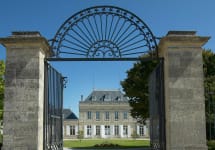Chateau Le Boscq 2015
-
James
Suckling -
Wine
Enthusiast



Product Details
Your Rating
Somm Note
Winemaker Notes
Blend: 48% Cabernet Sauvignon, 47% Merlot, 5% Petit Verdot
Professional Ratings
-
James Suckling
Very spicy and fresh with floral and currant character. Full to medium body and regal structure and intensity. Chocolate, tea and berry flavors. Tannins are polished and focused. Excellent finish. Drink in 2021.
-
Wine Enthusiast
The tannins in this wine are smooth, balancing the crisp fruit flavors and ample acidity. It's fruity and balanced, finishing on a black currant note.
Barrel Sample: 90-92
Other Vintages
2022- Decanter
-
Jeb
Dunnuck -
James
Suckling
-
Robert
Parker -
James
Suckling
-
Wine
Enthusiast -
Jeb
Dunnuck -
James
Suckling -
Wine
Spectator -
Robert
Parker
-
James
Suckling -
Wine
Enthusiast -
Wine
Spectator -
Robert
Parker - Decanter
-
Jeb
Dunnuck
-
Wine
Enthusiast -
James
Suckling -
Jeb
Dunnuck -
Wine
Spectator - Decanter
-
Wine
Enthusiast -
James
Suckling -
Wine
Spectator
-
James
Suckling -
Robert
Parker -
Jeb
Dunnuck -
Wine
Enthusiast -
Wine
Spectator - Decanter
-
Wine
Enthusiast -
James
Suckling
-
Wine
Enthusiast




Chateau Le Boscq’s reputation dates back to the conquest for the Medoc vineyard, when in 1749, Thomas Barton took over the tenancy at Chateau Le Boscq. For more than 30 years he dedicated his life to making wine of a quality repeatedly recognised, sometimes even at Cru Classé level, within the different classifications established in the 18th century by the courtiers and négociants in Bordeaux. At the end of the 19th century, Jean Grazilhon, whose grandfather was the estate’s steward working under Thomas Barton, become owner of the estate. He had the chateau built in 1891, a majestic residence enjoying views overlooking the Gironde estuary. For more than 30 years, he strived to produce high quality wines, paving the way for Chateau Le Boscq to be awarded Cru Bourgeois status in 1932. During this period, the estate’s wines were transported in barrels by barge as far as the port of Bordeaux. It is with reference to this historical fact, and to the location of the chateau by the estuary, that a barge now features on the labels as the emblem of the estate.

One of the world’s most classic and popular styles of red wine, Bordeaux-inspired blends have spread from their homeland in France to nearly every corner of the New World. Typically based on either Cabernet Sauvignon or Merlot and supported by Cabernet Franc, Malbec and Petit Verdot, the best of these are densely hued, fragrant, full of fruit and boast a structure that begs for cellar time. Somm Secret—Blends from Bordeaux are generally earthier compared to those from the New World, which tend to be fruit-dominant.

Deeply colored, concentrated, and distinctive, St. Estephe is the go-to for great, age-worthy and reliable Bordeaux reds. Separated from Pauillac merely by a stream, St. Estephe is the farthest northwest of the highest classed villages of the Haut Medoc and is therefore subject to the most intense maritime influence of the Atlantic.
St. Estephe soils are rich in gravel like all of the best sites of the Haut Medoc but here the formation of gravel over clay creates a cooler atmosphere for its vines compared to those in the villages farther downstream. This results in delayed ripening and wines with higher acidity compared to the other villages.
While they can seem a bit austere when young, St. Estephe reds prove to live very long in the cellar. Traitionally dominated by Cabernet Sauvignon, many producers now add a significant proportion of Merlot to the blend, which will soften any sharp edges of the more tannic, Cabernet.
The St. Estephe village contains two second growths, Chateau Montrose and Cos d’Estournel.
